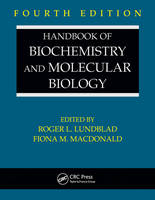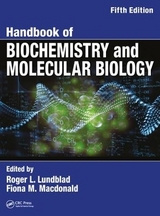
Handbook of Biochemistry and Molecular Biology
Crc Press Inc (Verlag)
978-0-8493-9168-2 (ISBN)
- Titel erscheint in neuer Auflage
- Artikel merken
Edited by renowned protein scientist and bestselling author Roger L. Lundblad, with the assistance of Fiona M. Macdonald of CRC Press, this fourth edition of the Handbook of Biochemistry and Molecular Biology represents a dramatic revision — the first in two decades — of one of biochemistry's most referenced works. This edition gathers a wealth of information not easily obtained, including information not found on the web.
Offering a molecular perspective not available 20 years ago, it provides physical and chemical data on proteins, nucleic acids, lipids, and carbohydrates. Presented in an organized, concise, and simple-to-use format, this popular reference allows quick access to the most frequently used data. Covering a wide range of topics, from classical biochemistry to proteomics and genomics, it also details the properties of commonly used biochemicals, laboratory solvents, and reagents.
Just a small sampling of the wealth of information found inside the handbook:
Buffers and buffer solutions
Heat capacities and combustion levels
Reagents for the chemical modification of proteins
Comprehensive classification system for lipids
Biological characteristics of vitamins
A huge variety of UV data
Recommendations for nomenclature and tables in biochemical thermodynamics
Guidelines for NMR measurements for determination of high and low pKa values
Viscosity and density tables
Chemical and physical properties of various commercial plastics
Generic source-based nomenclature for polymers
Therapeutic enzymes
About the Editors:
Roger L. Lundblad, Ph.D.
Roger L. Lundblad is a native of San Francisco, California. He received his undergraduate education at Pacific Lutheran University and his PhD degree in biochemistry at the University of Washington. After postdoctoral work in the laboratories of Stanford Moore and William Stein at the Rockefeller University, he joined the faculty of the University of North Carolina at Chapel Hill. He joined the Hyland Division of Baxter Healthcare in 1990. Currently Dr. Lundblad is an independent consultant and writer in biotechnology in Chapel Hill, North Carolina. He is an adjunct Professor of Pathology at the University of North Carolina at Chapel Hill and Editor-in-Chief of the Internet Journal of Genomics and Proteomics.
Fiona M. Macdonald, Ph.D., F.R.S.C.
Fiona M. Macdonald received her BSc in chemistry from Durham University, UK. She obtained her PhD in inorganic biochemistry at Birkbeck College, University of London, studying under Peter Sadler. Having spent most of her career in scientific publishing, she is now at Taylor and Francis and is involved in developing chemical information products.
Lundblad Biotechnology, Chapel Hill, North Carolina, USA CRC Press, Boca Raton, Florida, USA
Amino Acids, Peptides and Proteins
Properties of Amino Acids
Data on the Naturally Occurring Amino Acids
Structures and Symbols for Synthetic Amino Acids Incorporated Into Synthetic Polypeptides
Unnatural Amino Acids for Incorporation into Proteins
Properties of the α-Keto Acid Analogs of Amino Acids
α,ß-Unsaturated Amino Acids
Amino Acid Antagonists
Coefficients of Solubility Equations of Certain Amino Acids in Water
Heat Capacities, Absolute Entropies, and Entropies of Formation of Amino Acids and Related Compounds
Heat of Combustion, Enthalpy and Free Energy of Formation of Amino Acids and Related Compounds
Solubilities of Amino Acids in Water at Various Temperatures
Heats of Solution of Amino Acids in Aqueous Solution at 25°C
Free Energies of Solution and Standard Free Energy of Formation of Amino Acids in Aqueous Solution at 25°C
Far Ultraviolet Absorption Spectra of Amino Acids
UV Absorption Characteristics of N-Acetyl Methyl Esters of the Aromatic Amino Acids, Cystine and of N-Acetylcysteine
Numerical Values of the Absorbances of the Aromatic Amino Acids in Acid, Neutral and Alkaline Solutions
Luminescence of the Aromatic Amino Acids
Luminescence of Derivatives of the Aromatic Amino Acids
Luminescence of Proteins Lacking Tryptophan
Luminescence of Proteins Containing Tryptophan
Hydrophobicities of Amino Acids and Proteins
Chemical Specificity of Reagents for Protein Modification
Reagents for the Chemical Modification of Proteins
Protein pK Values
Protease Inhibitors and Protease Inhibitor Cocktails
Assay of Solution Protein Concentration
Spectrophotometric Determination of Protein Concentration in the Short-Wavelength Ultraviolet
Lipids
A Comprehensive Classification System for Lipids
Properties of Fatty Acids and Their Methyl Esters
Densities, Specific Volumes, and Temperature Coefficients of Fatty Acids from C8 to C12
Composition and Properties of Common Oils and Fats
Androgens
Bile Acids
Corticoids
Estrogens
Progestogens
Sterols
Prostaglandins and Related Fatty-Acid Derived Materials
Vitamins and Coenzymes
Properties of Vitamins
Biological Characteristics of Vitamins
Properties for Ascorbic Acid and Ascorbate-2-Sulfate
Vitamers
Vitamin Names Discarded
Nucleic Acids
UV Spectral Characteristics and Acidic Dissociation Constants of 280 Alkyl Bases, Nucleosides, and Nucleotides
Ultraviolet Absorbance of Oligonucleotides Containing 2′-O-Methylpentose Residues
Spectrophotometric Constants of Ribonucleotides
Purines, Pyrimidines, Nucleosides, and Nucleotides: Physical Constants and Spectral Properties
Chemical Modification of Nucleic Acids
Transfection Technologies
Carbohydrates
Introduction to Carbohydrates
Natural Alditols, Inositols, Inososes, and Amino Alditols and Inosamines
Natural Acids of Carbohydrate Derivation
Natural Aldoses
Natural Ketoses
Carbohydrate Phosphate Esters
The Naturally Occurring Amino Sugars
Oligosaccharides (Including Disaccharides)
Mucopolysaccharides (Glycosaminoglycans)
Physical and Chemical Data
Recommendations for Nomenclature and Tables in Biochemical Thermodynamics
Standard Transformed Gibbs Energies of Formation for Biochemical Reactants
Enthalpy, Entropy, and Free Energy Values for Biochemical Redox Reactions
Oxidation-Reduction Potentials, Absorbance Bands and Molar Absorbance of Compounds used in Biochemical Studies
Calorimetric ΔH Values Accompanying Conformational Changes of Macromolecules in Solution
Free Energies of Hydrolysis and Decarboxylation
Deci-Normal Solutions of Oxidation and Reduction Reagents
Guidelines for Potentiometric Measurements in Suspensions Part A. The Suspension Effect
Ionization Constants of Acids and Bases
Guidelines for NMR Measurements for Determination of High and Low pKa Values
Measurement and Interpretation of Electrokinetic Phenomena
Measurement of pH Definition, Standards, and Procedures
General Comments on Buffers
List of Buffers
Bronsted Acidities
Measurement of pH
Buffer Solutions
Amine Buffers Useful for Biological Research
Preparation of Buffers for Use in Enzyme Studies
Buffer for Acrylamide Gels (Single-Gel Systems)
Starch Gels
Indicators for Volumetric Work and pH Determinations
Acid and Base Indicators
Specific Gravity of Liquids
Viscosity and Density Tables
A Listing of Log P Values, Water Solubility, and Molecular Weight for Some Selected Chemicals
Chemicals Commonly Used in Biochemistry and Molecular Biology and Their Properties
Common Detergents Used in Biochemical Research
Some Properties of Detergents and Surfactants Used in Biochemistry and Molecular Biology
Some Biological Stains and Dyes
Mordant Dyes
Metal Chelating Agents
Water
Stability of Solutions for GLP and cGMP Use
General Information on Spectroscopy
Microplates
Plastics
Chemical and Physical Properties of Various Commercial Plastics
Generic Source-Based Nomenclature for Polymers
Definitions of Terms Relating to Reactions of Polymers and to Functional Polymeric Materials
Definitions of Terms Related to Polymer Blends, Composites, and Multiphase Polymeric Materials
Organic Name Reactions Useful in Biochemistry and Molecular Biology
Enzymes in Synthetic Organic Chemistry
Therapeutic Enzymes
Weights of Cells and Cell Constituents
Particle Diameter
Appendix A: Abbreviations and Acronyms
Appendix B: Glossary of Terms Useful in Biochemistry
Index
| Erscheint lt. Verlag | 21.5.2010 |
|---|---|
| Zusatzinfo | over 100 equations; 173 Tables, black and white; 983 Illustrations, black and white |
| Verlagsort | Bosa Roca |
| Sprache | englisch |
| Maße | 216 x 279 mm |
| Gewicht | 2790 g |
| Themenwelt | Naturwissenschaften ► Biologie ► Genetik / Molekularbiologie |
| ISBN-10 | 0-8493-9168-7 / 0849391687 |
| ISBN-13 | 978-0-8493-9168-2 / 9780849391682 |
| Zustand | Neuware |
| Haben Sie eine Frage zum Produkt? |
aus dem Bereich



